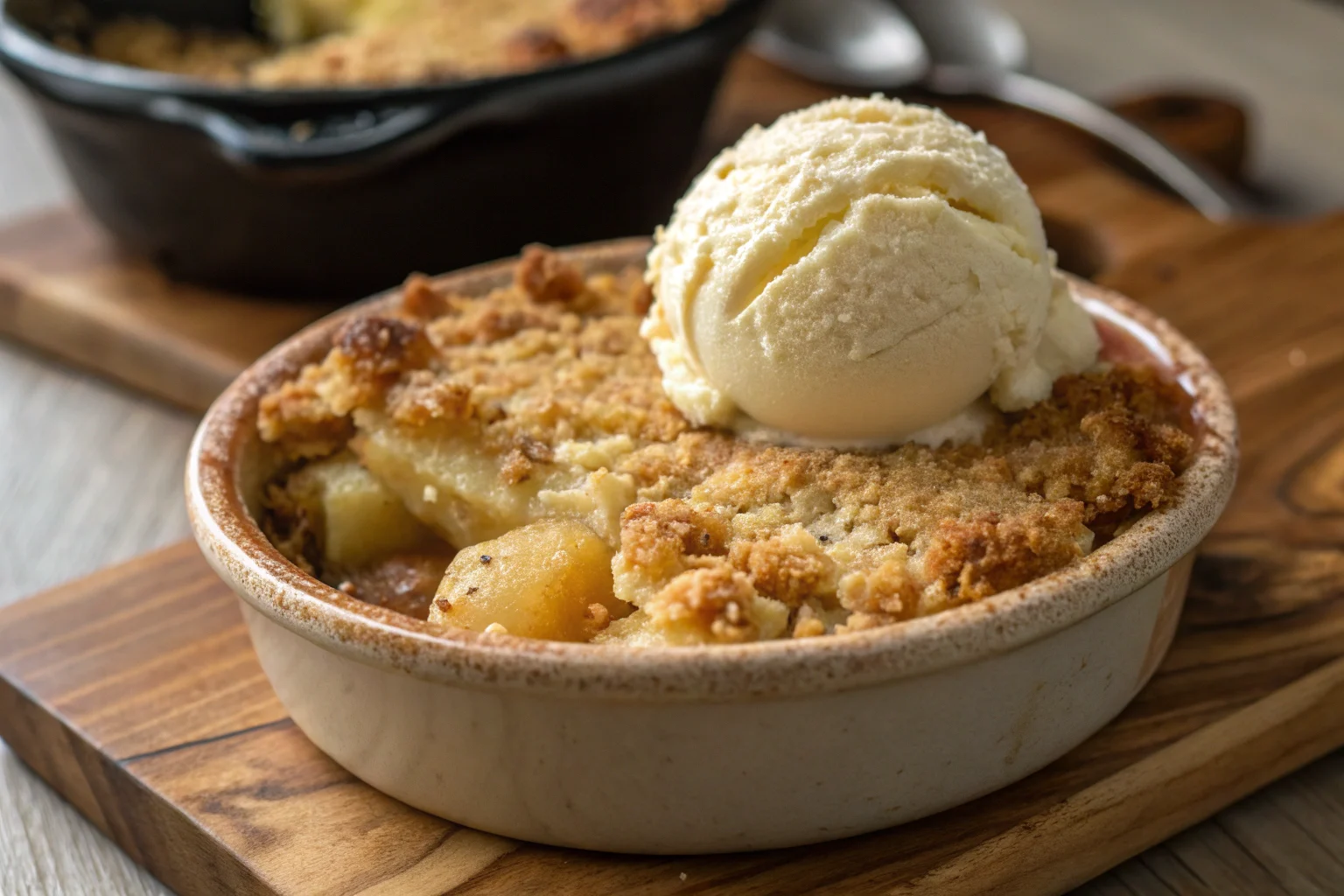Let’s face it—there’s nothing quite like digging into a warm, buttery crumble on a chilly evening. Whether it’s topped with apples, peaches, or berries, this dessert is a classic for a reason. But what makes a crumble truly unforgettable? Is it the topping, the filling, or some magical secret ingredient? Spoiler alert: it’s a little bit of everything. In this guide, we’ll uncover the secrets to a good crumble, from nailing that perfect topping to choosing the right fruit. Plus, I’ll throw in a few tips to help you avoid common pitfalls. Ready to whip up a dessert that’ll make you the talk of the table? Let’s get started!
The Basics of a Crumble
What Exactly Is a Crumble?
A crumble is the epitome of cozy desserts, but what is the secret to a good crumble? It’s all about balancing the topping’s texture and flavor with the perfect fruit filling.The beauty of a crumble lies in its simplicity—it’s fuss-free and doesn’t require any fancy skills. Unlike cobblers, which have a biscuit-like topping, or crisps, which often feature oats, a crumble keeps things straightforward with a classic buttery crunch.
Pro Tip: Want to understand the difference between crumbles, crisps, and cobblers? Check out this handy guide.
Key Ingredients for a Classic Crumble
A good crumble starts with a few pantry staples:
- Flour: All-purpose flour works best for that signature texture.
- Sugar: Use granulated sugar for sweetness and brown sugar for depth.
- Butter: Cold, unsalted butter is non-negotiable. It’s the backbone of the topping.
The Secret to Good Crumble Texture
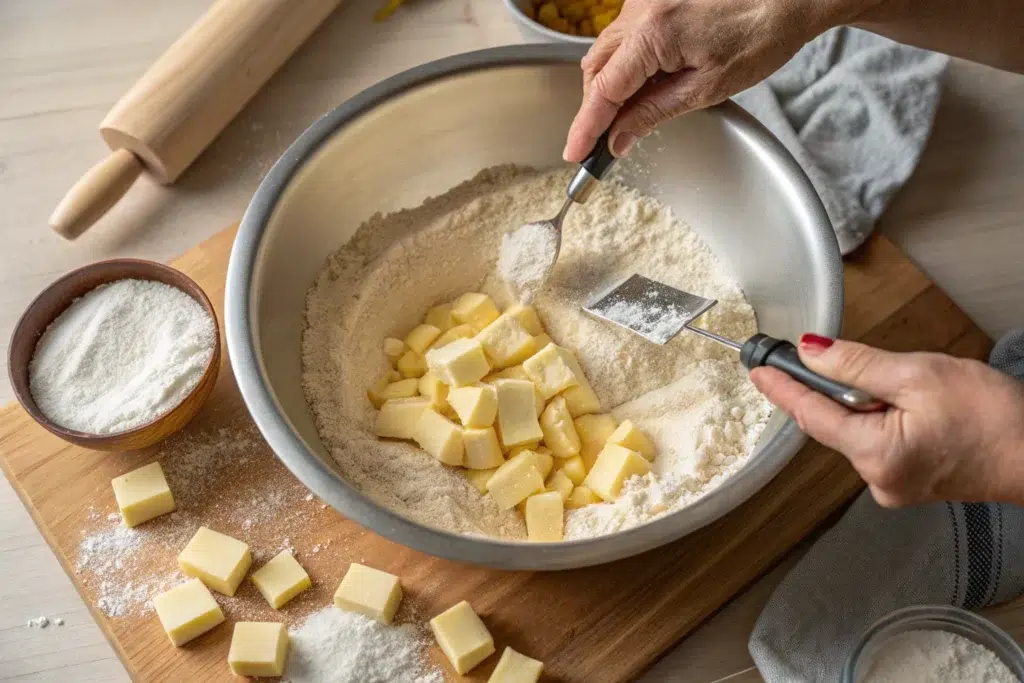
Balancing the Right Ratio of Flour, Sugar, and Butter
The magic ratio? Equal parts flour, sugar, and butter. This ensures your topping is crumbly, not cakey. Too much butter? You’ll end up with a greasy mess. Too little? The topping will lack that melt-in-your-mouth factor.
Why Cold Butter Is a Game-Changer
Cold butter is at the heart of what is the secret to a good crumble. When combined with flour and sugar in the right ratios, it creates that signature crumbly texture that’s light yet satisfying. When it melts in the oven, it creates pockets of air that give the crumble its light texture. Use a pastry cutter or your fingertips to mix the butter into the dry ingredients—stop when it resembles coarse sand.
The Importance of a Crumbly (Not Doughy) Texture
The topping should clump together when you press it but easily crumble apart. If it’s sticking together like cookie dough, add a little more flour.
Choosing the Perfect Fruit
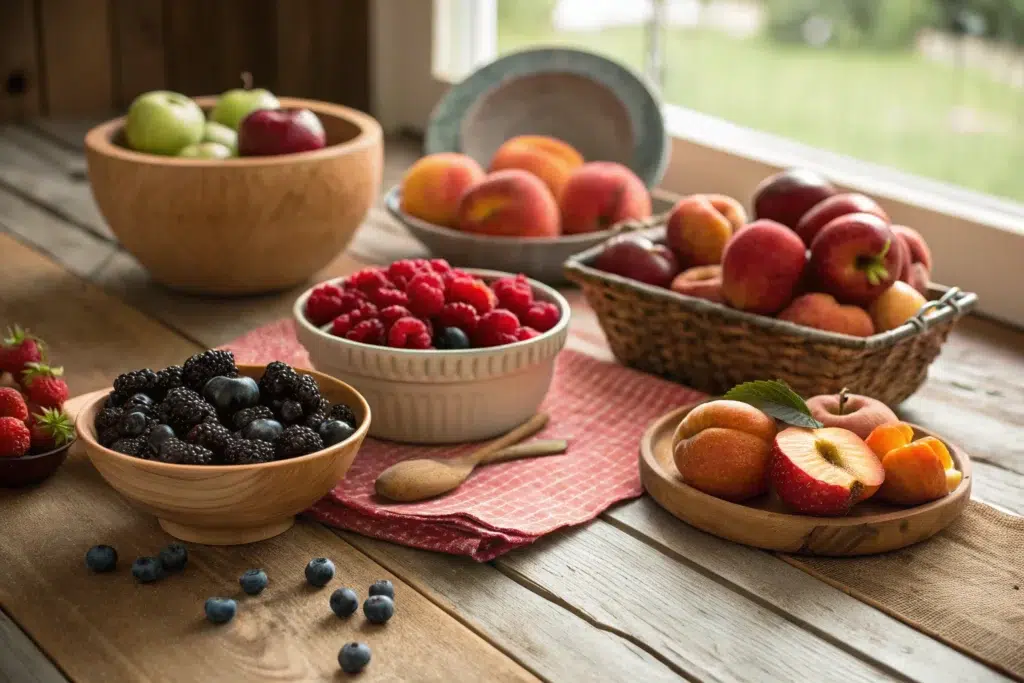
Best Fruits for a Crumble
The right fruit choice is essential in mastering what is the secret to a good crumble. Classic choices include apples, peaches, and berries. But don’t be afraid to get creative—plums, pears, or even tropical fruits like mango work beautifully.
Combining Fruits for Unique Flavor Profiles
Mixing fruits can elevate (oops, scratch that—improve!) your crumble game. Try pairing tart rhubarb with sweet strawberries or apples with cranberries for a seasonal twist.
Should You Pre-Cook the Fruit?
Pre-cooking is optional, but it can help prevent a watery filling. If your fruit is particularly juicy (looking at you, peaches), toss it with a little cornstarch before layering.
Need inspiration? Check out this Peach Crumble Recipe for the ultimate summer dessert.
Tips for a Flavorsome Crumble
Adding Spices and Aromatics
Cinnamon and nutmeg are classics, but don’t stop there. A pinch of cardamom or a splash of vanilla extract can add layers of flavor.
The Role of Sugar: Balancing Sweetness
Use a mix of granulated and brown sugar for a crumble that’s sweet but not cloying. Brown sugar adds a subtle molasses note that’s irresistible.
Experimenting with Nuts, Oats, or Coconut
Adding chopped nuts, rolled oats, or shredded coconut to your topping can take it to the next level. Just keep the ratios balanced—too many extras can overpower the crumble.
Technique Matters
How to Rub Butter into Flour Like a Pro
figuring out what is the secret to a good crumble is what separates an average dessert from one that leaves everyone asking for seconds. This step might sound intimidating, but it’s surprisingly simple (and kind of fun). Use your fingertips to pinch and rub the cold butter into the flour-sugar mixture. The goal is to work quickly—cold butter is key to a light crumble, so don’t let it melt. If your kitchen is warm, you can chill the bowl and utensils beforehand.
If you prefer to skip the hands-on approach, a food processor works too. Pulse the ingredients just until the mixture looks like coarse crumbs.
Pro Tip: Check out this guide to perfect pie crusts for similar butter-handling tips—it’s all about keeping things cool!
Layering the Fruit and Topping Correctly
This might seem straightforward, but there’s an art to it. Start with a thick, even layer of fruit in your baking dish. Sprinkle the topping generously over the fruit—don’t press it down. You want the topping to sit loosely so the fruit juices bubble up and caramelize the edges.
Baking Temperature and Timing
Bake your crumble at 350°F for 35–45 minutes. The fruit should be bubbly and tender, and the topping should be golden brown. Keep an eye on it during the last 10 minutes—if the topping is browning too quickly, cover it loosely with foil.
Avoiding Common Crumble Mistakes
Why Your Crumble Might Turn Out Soggy
Soggy crumble? That’s a bummer. The culprit is usually too much liquid from the fruit. To avoid this:
- Toss your fruit with a thickener like cornstarch or flour.
- Drain any excess juice from overly ripe or frozen fruit before baking.
Preventing Overbaking or Undercooking
Overbaked crumble can taste dry, while undercooked topping feels raw. Stick to the suggested baking time, but also rely on visual cues. If the topping looks pale, give it a few extra minutes.
Serving the Perfect Crumble
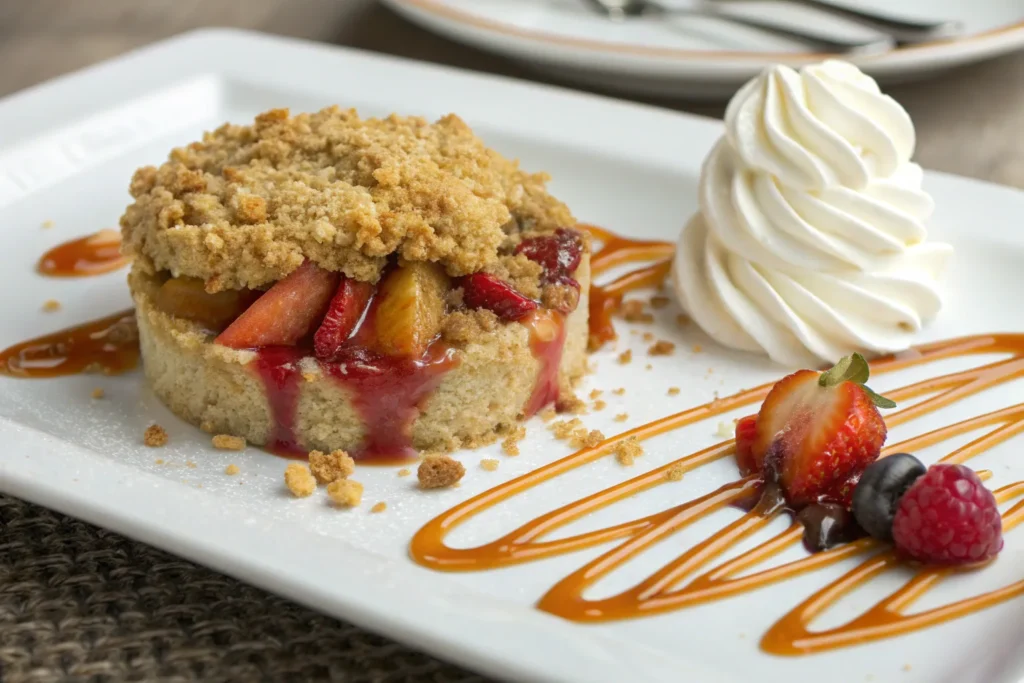
Pairing Your Crumble with the Right Sauces or Ice Cream
Nothing says comfort like a warm crumble topped with a scoop of vanilla ice cream. Other great pairings include:
- Whipped cream for a lighter touch.
- A drizzle of caramel sauce for added indulgence.
- Custard if you’re feeling nostalgic (or British).
Looking for more dessert pairings? This creamy custard recipe is a must-try.
Warm or Cold? The Best Way to Serve
While a crumble is heavenly straight out of the oven, letting it cool slightly allows the flavors to meld and the topping to crisp up. Leftovers (if there are any) are equally delicious cold or reheated in the oven.
Secrets Passed Down from the Pros
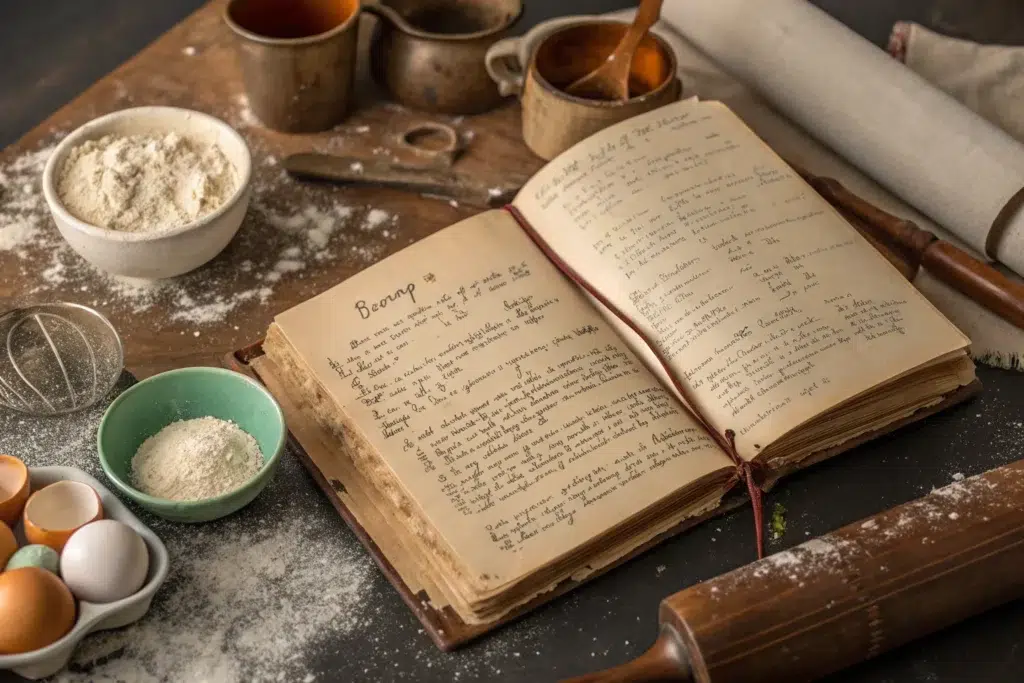
Grandma’s Tips: How to Keep It Simple Yet Perfect
Some of the best crumbles come from recipes passed down through generations. Here are a few timeless tips:
- Always use unsalted butter for better control over the flavor.
- Mix a pinch of salt into the topping to enhance the sweetness.
- Keep things rustic—don’t overthink it.
Modern Twists: Adding a Touch of Sophistication
Want to impress your guests? Try these upgrades:
- Add a splash of liqueur like amaretto or Grand Marnier to the fruit.
- Incorporate crushed ginger snaps or biscotti into the topping for an extra crunch.
- Sprinkle some flaky sea salt on top before serving—it’s a game-changer!
Quick Crumble Recipe for Beginners
Let’s wrap up with a foolproof recipe:
Classic Apple Crumble
Ingredients:
- 4 medium apples, peeled and sliced
- 1 tbsp lemon juice
- 1/4 cup granulated sugar
- 1 tsp cinnamon
- 1 cup all-purpose flour
- 1/2 cup brown sugar
- 1/2 cup unsalted butter, cold and cubed
Instructions:
- Preheat your oven to 350°F. Grease a baking dish.
- Toss the apples with lemon juice, sugar, and cinnamon. Spread evenly in the dish.
- In a bowl, combine flour and brown sugar. Rub in the butter until the mixture looks like coarse crumbs.
- Sprinkle the topping over the apples.
- Bake for 35–40 minutes, or until golden and bubbly. Serve warm with ice cream.
Conclusion
A good crumble is all about balance—the right ingredients, proper technique, and just a touch of creativity. Whether you’re sticking to a traditional apple crumble or experimenting with unique fruit and topping combinations, the secrets we’ve shared here will help you achieve dessert perfection. Remember, the key is to keep it simple, use cold butter, and layer your topping loosely for that golden, crisp finish.
Crumbles aren’t just desserts; they’re a symbol of comfort and tradition. With these tips, you’re not just making a dish—you’re creating a memory. Now, grab your favorite fruit, preheat that oven, and let your crumble magic begin!
FAQs: Answers to Your Crumble Questions
What is the secret to a good crumble?
The secret lies in balancing ingredients and technique. Use cold butter, rub it into the flour and sugar until it forms coarse crumbs, and layer it loosely over the fruit. Adding a pinch of salt or extras like oats or nuts can elevate the texture and flavor.
How do I make my crumble more crumbly?
To achieve a more crumbly texture, increase the flour-to-butter ratio. Ensure the butter is cold and mix it gently to form large and small crumbs. Avoid overmixing as that can lead to a doughy consistency.
What is the secret to a good crumble without butter?
If you’re skipping butter, use alternatives like coconut oil, margarine, or olive oil. Keep the fat chilled (if solid) and incorporate it just as you would butter. Coconut oil works well for a subtle flavor twist.
Is it better to crumble with cold or melted butter?
Cold butter is always better for crumbles. When baked, it creates pockets of air, resulting in a light and crispy texture. Melted butter, on the other hand, can lead to a dense and overly moist topping.
Why is my crumble not crispy?
A soggy crumble could mean too much butter or not enough flour. It could also result from excess liquid from the fruit. To fix this, toss the fruit with a thickener like cornstarch and use a balanced ratio of ingredients in the topping.
What happens if you put too much butter in crumble?
Too much butter can make the crumble topping greasy and cause it to clump together, losing its signature crumbly texture. If this happens, add more flour and sugar to balance it out.
Why put baking powder in crumble topping?
Baking powder isn’t always necessary, but a small amount can make the topping slightly lighter and puffier. It’s a personal preference and can be skipped if you prefer a denser texture.

